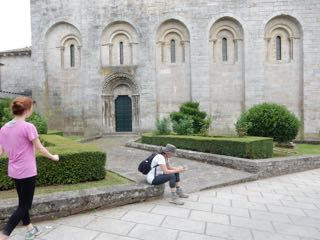“The Way”, it is called – this Camino a Santiago de Compostela, a challenge for the faithful, to reduce themselves to bodies walking and climbing, carrying the minimum, facing obstacles Mother Nature can throw before them, from the heat of the bright yellow sun of Spain to vicious winds whistling through the many evergreen trees and poplars covering every level of mountain up which each pilgrim must climb – at their speed – so they can come down the other side and reach their destination for the night.
Basically, the entire Camino route starts in Paris, France, which attracts the bicyclers and they are brightly dressed as if they were in a race. Some walkers start in the Basque area of France, about 500 miles away, across the top of Spain, to get to Santiago. Although in history there had been unmarked pilgrimages to Jerusalem and to Rome, since 1993, a Holy Year for Spain, this trek to Santiago has been seriously marked – yellow arrows painted on stone walls, or in the middle of the highways, on corners, and plaques of wood, showing the pilgrim which way to follow. There is usually about 24 kilometers (13-15 miles) per day to be covered, so everyone who starts out at the same place on the same day relatively lands in the same center, where albergues and paradors await with simplicity – beds, showers, laundry and beer. Lots of bars pepper the Way and that means food and drink are available in the most remote area. It is now a business and has given many people employment.
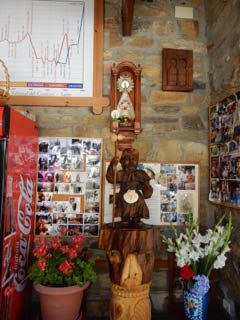 There is nothing tougher than the toil of each day on the Way. We are called Pilgrims. We are identified by scallop shells which we tie on our gear – symbols of St. James, the saint, whose remains were found in the ninth century and the Cathedral built to house them, so that worshipers, admirers, pilgrims had a destination. St James was the Greater, not the brother of Christ. We dress in old T-shirts, shorts, hiking boots, backpacks with pockets for water, hats and walking sticks (poles or wooden sticks). The yellow arrows become our Yellow Brick Road, and we follow them as if there was gold at the end. As pilgrims pass each other (because you pass someone and they pass you and then you might pass again) they issue “Buen Camino” (A good Way). But most important is we must have a Pilgrim Passport Credential, in order to stay at pilgrim hotels, and to receive the certificate of completion of pilgrimage to Santiago (called a compostela), one needs to have filled his passport with rubber stamp impressions, given by those who run the pilgrim hostels, and also at cathedrals, churches, town halls, bars, and restaurants along the way. If you’ve been there, it’s legit. Getting the passports is not always easy. Many places have run out of them. So our guide worked on ours as soon as we got on the Way.
There is nothing tougher than the toil of each day on the Way. We are called Pilgrims. We are identified by scallop shells which we tie on our gear – symbols of St. James, the saint, whose remains were found in the ninth century and the Cathedral built to house them, so that worshipers, admirers, pilgrims had a destination. St James was the Greater, not the brother of Christ. We dress in old T-shirts, shorts, hiking boots, backpacks with pockets for water, hats and walking sticks (poles or wooden sticks). The yellow arrows become our Yellow Brick Road, and we follow them as if there was gold at the end. As pilgrims pass each other (because you pass someone and they pass you and then you might pass again) they issue “Buen Camino” (A good Way). But most important is we must have a Pilgrim Passport Credential, in order to stay at pilgrim hotels, and to receive the certificate of completion of pilgrimage to Santiago (called a compostela), one needs to have filled his passport with rubber stamp impressions, given by those who run the pilgrim hostels, and also at cathedrals, churches, town halls, bars, and restaurants along the way. If you’ve been there, it’s legit. Getting the passports is not always easy. Many places have run out of them. So our guide worked on ours as soon as we got on the Way.
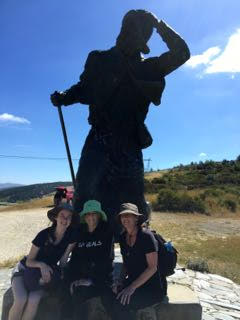 One travels through rocky pathways, dusty dirt ones, over large rocks, around walls of stone, buildings of stone, chapels of stone, boulders and fragrant villages where the cattle industry reins. It’s not unusual to run into a herd of the healthiest looking steers and milk cows I’ve ever seen, (these are not the black Corrientes bred strictly for bull fighting) and there are sheep with them, sometimes goats, and the noise of pigs (they eat a lot of pork here) can be heard in the background. Fields are rich with sun flowers, all facing toward the bright Spanish sun, wheat, corn twice as high as I am, and curious forms of cabbage, which ends up in the Galego Soup we eat at lunch. The villages are quaint, ancient and quiet. Pelargoniums, roses, gladiolas, all sorts of purple, red and bright pink flowers make them a joy to behold.
One travels through rocky pathways, dusty dirt ones, over large rocks, around walls of stone, buildings of stone, chapels of stone, boulders and fragrant villages where the cattle industry reins. It’s not unusual to run into a herd of the healthiest looking steers and milk cows I’ve ever seen, (these are not the black Corrientes bred strictly for bull fighting) and there are sheep with them, sometimes goats, and the noise of pigs (they eat a lot of pork here) can be heard in the background. Fields are rich with sun flowers, all facing toward the bright Spanish sun, wheat, corn twice as high as I am, and curious forms of cabbage, which ends up in the Galego Soup we eat at lunch. The villages are quaint, ancient and quiet. Pelargoniums, roses, gladiolas, all sorts of purple, red and bright pink flowers make them a joy to behold.
The Pilgrim is either going severely upwards (terrible on the calf muscles), or severely down (ditto) and everyone is relieved when there is a flat period. If it rains, each throws a rain slicker over his companions wearing backpack , so that everyone resembles the Hunchback of Notre Dame as they walk on by. This is a mountainous part of Spain and there is lovely landscape no matter where you turn your head to look, and towns are made mostly of stone and concrete buildings. Pilgrims are also follow those yellow arrows through towns and villages, rather than avoiding these things, and everyone pushes on and on with a determination rarely seen, battling thirst, aching backs, and blisters and corns on overused feet. Taking care of feet is primary, and it amazes me that no one has set up stations for feet and leg massages!!! It’s important to be in shape, but also to give body, mind, soul and leg muscles a chance to acclimatize. I’m blessed because I don’t have to carry all my belongings in a backpack, but the essentials (including water and electrolite tablets) are in my fanny pack, along with my cellphone to take photos and some coins to drop here and there.
At the Cathedral in Santiago, those on foot who have completed a minimum of 100 kilometer (60 miles) or bicyclistas must do 200 kilometers, will receive certificates of accomplishment. All along the way, with the Pilgrims Passport in hand, one accumulates stamps from shelters, churches, shops, bars, and anything where you might stop a moment. This records your journey and each ink stamp will bring up satisfying memories of the Camino in the future. Many pilgrims become addicted to the effort, to the natural camaraderie and return many times to do it again. It’s a way of reuniting with old Pilgrim friends. Some do it in bits and pieces, others in sections (like one third this year, 2nd third next year and 3rd third following year.) It has an attraction that softly blesses the ego, the soul, the heart. It’s not like a crowded thing, not bumper to bumper people, – there is a lot of aloneness, for me, particularly, because I’m slower than my daughter and granddaughter, 14, who dances her way down paths and through fields, to our delight. Oh to be young again!! It’s not about beauty, no one wants to look in mirrors because there is no time to primp and look good. It’s not about that, but about survival, and dealing with stiff calf muscles, and painful ankles and getting the next meal. Some move in packs. All are concerned to stay hydrated. Water is everywhere, and there are public “sinks”, I would call them, where fresh water can be had to refill your bottle. But, God has mercy on us the lowly Pilgrims, as he always has, and somehow we extort negativity thinking that dictates our lives, so that we can meditate and mediate with the purest of heart, and prayer touches on that peace, that silence, we all seek.
I’ve been curious because there is not that many “religious” attractions along the route, I don’t know if religion is discussed, or the whys of each other’s pilgrimage, what baggage each brought with him or her, and what the results are when they consume the Pilgrim’s Mass at the Cathedral upon arrival. We stop at churches and chapels, but rarely do we see other pilgrims doing the same, but we are charmed by the offerings, the art, the simplicity and feeling of faith one can find in the refuge of the Catholic churches.
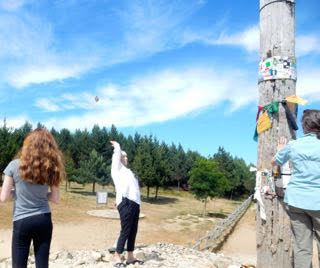 It’s been a wrenching challenge for me. I’ve set out on many Pilgrimages, but this one is dead serious and long and tedious and often very lonely. I was hardly able to make it to the various points early on (being aerobically unfit), and was too involved in trying to clean up the parts of my life – the anger, the hatred, the self-worry, the angst, the doubts – because I want to leave them here on the trail. At one point after lunch the second day, the three of us started together (normal) and Megan began to sing Johnny Cash songs – like Folsom Prison and the Pilgrim. We roared with laughter and then I realized I could get music on my cell phone – and what better than the score from The Jersey Boys. It was unbelievable how this perked up my spirits, got my feet moving rather than dragging, and I too started dancing down the trail and that has been my vehicle to get where I had to get – music with a beat. I haven’t heard anyone else doing this, but it’s my way. And whatever way you have to do it, is OK – it’s between you and God. And my God has a great sense of humor.
It’s been a wrenching challenge for me. I’ve set out on many Pilgrimages, but this one is dead serious and long and tedious and often very lonely. I was hardly able to make it to the various points early on (being aerobically unfit), and was too involved in trying to clean up the parts of my life – the anger, the hatred, the self-worry, the angst, the doubts – because I want to leave them here on the trail. At one point after lunch the second day, the three of us started together (normal) and Megan began to sing Johnny Cash songs – like Folsom Prison and the Pilgrim. We roared with laughter and then I realized I could get music on my cell phone – and what better than the score from The Jersey Boys. It was unbelievable how this perked up my spirits, got my feet moving rather than dragging, and I too started dancing down the trail and that has been my vehicle to get where I had to get – music with a beat. I haven’t heard anyone else doing this, but it’s my way. And whatever way you have to do it, is OK – it’s between you and God. And my God has a great sense of humor.
There are plenty of spots to stop for refreshment. There is a Pilgrim’s Menu – which is an overload of good food and carbs. Usually one starts with Sopa Galego, a rich broth with greens, cauliflower, cabbage, and potato; then comes pasta (mostly macaroni size), and after that meat with a huge platter of short French Fries. Deserts are cakes and in some area, because cheese is major here, a delicious cream cheese mixed with honey gets the pilgrim going for the afternoon sessions.
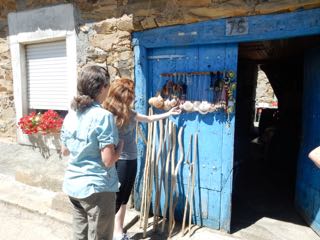 Amazing there are not souvenier shops at every corner. At the beginning since our guide knew the ropes, we were taken to the modest home of an old couple who make walking sticks and scallop shells to hang on our backpacks. It was a delight. We were told to go into the field and find a rock that was big enough to hold all our sins – (there wasn’t one my size) but I found an alabaster one about as big as two baseballs, and when we arrived at a special place at the highest point on the trail called the Iron Cross – (made as a marker for winter when snow is deep so the path could be followed). We then silently communicated with our bad/negative side, blew it into the stone, and then tossed it backwards pass the tall post on which the cross is secured.
Amazing there are not souvenier shops at every corner. At the beginning since our guide knew the ropes, we were taken to the modest home of an old couple who make walking sticks and scallop shells to hang on our backpacks. It was a delight. We were told to go into the field and find a rock that was big enough to hold all our sins – (there wasn’t one my size) but I found an alabaster one about as big as two baseballs, and when we arrived at a special place at the highest point on the trail called the Iron Cross – (made as a marker for winter when snow is deep so the path could be followed). We then silently communicated with our bad/negative side, blew it into the stone, and then tossed it backwards pass the tall post on which the cross is secured.
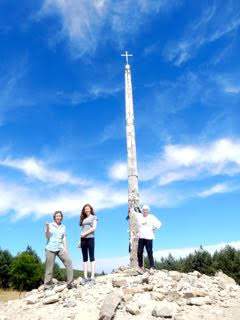 Life goes on as we go by. A rooster crowed at 3 p.m. A tiny yellow butterfly leaped from little purple flower to little purple flower. An ancient man carries a jug of water. A lady is housecleaning. It’s very rural, the life here, and wealth doesn’t hover on the Way. Good people do, but no longer curious about the pilgrims, who come from every corner of the earth, they are so accustomed to them, 250,000 pilgrims pass by each year (in a Holy Year (2021), it doubles.
Life goes on as we go by. A rooster crowed at 3 p.m. A tiny yellow butterfly leaped from little purple flower to little purple flower. An ancient man carries a jug of water. A lady is housecleaning. It’s very rural, the life here, and wealth doesn’t hover on the Way. Good people do, but no longer curious about the pilgrims, who come from every corner of the earth, they are so accustomed to them, 250,000 pilgrims pass by each year (in a Holy Year (2021), it doubles.
Life must go on the natural way. And Pilgrims are going to be suffering the max trying to get in 13-15 miles per day. All have that one focus to “get there”, to pay homage to St. James the Greater, to complete their task and hopefully have deep discussions with their hearts and souls, to have found something more wonderful about themselves, something that can change their lives. For sure, most will be sun burned on the left sides – as they always walk to the West, when the sun curves around each day, it passes on the left, so that’s where the sun burn is more severe. A mark of a Pilgrim to Santiago.


